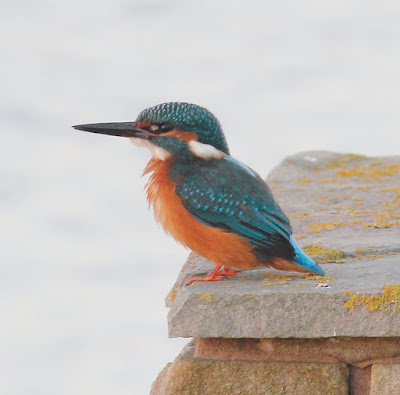It was 0600 and still fairly dark. The sky was overcast, there had been a recent shower and a cold northerly rippled through the garden trees.
Birding or ringing was the predicament. Birding takes no effort and starts as soon as the car hits the road and ends when the car is back on the driveway. A ringing session entails a 30 minute car journey followed by setting nets, checking equipment, and then slogging around the nets every 20/25 minutes to process the birds. And then at the end of the session it's time do everything again but this time in reverse order. Although rewarding the many physical tasks involved in ringing make for hard graft when compared to a spot of leisurely birding. So I postponed the ringing until a day or two when the isobars are due to open out, the sun is promised to shine and I may be more motivated.
By the time I reached Glasson Dock the clouds had thinned and the sun was out. But the temperature felt more like November than September, even with three layers up top and a woolly hat.
I parked up and waited for a Kingfisher to appear. One duly arrived from nowhere, landed on a nearby boat but didn’t hang around for more than a couple of clicks of the shutter button.
Kingfisher
The Swallows have increased and I counted upwards of 450 of them milling around the boats, sitting along the rails and rigging and feeding over the yacht basin. Take a close look at the picture below, where believe it or not, there are about 200 Swallows scattered across various parts of the assembled boats.
Swallows at Glasson
Fish were literally jumping out of the water, hence the Kingfisher, Grey Heron and several Cormorants, all looking for a meal. Tufted Ducks now number nine as we await more autumn arrivals, likewise the Coots, steady at less than twenty. Along the towpath and around the bowling green I counted 3 Pied Wagtail, 1 Grey Wagtail and upwards of 60 House Sparrows.
Cormorant
Pied Wagtail
It was time for a look at Conder Green where, yes you’ve guessed it, a Kingfisher sat in waiting. This one was not so accommodating and before I could request a “cheese” the bird was off across the pool like a rocket. Lest anyone should think our local Kingfishers are easy to photograph, they are not, it is simply that there are lots of Kingfishers about at the moment; it’s an infrequent situation which increases the chances of getting pictures of what is by common consent, a shy species.
Conder Green
Although not numerous this morning’s waders and wildfowl revealed a good selection consisting of 32 Teal, 6 Curlew, 4 Common Sandpiper, 2 Greenshank, 1 Ruff, 1 Snipe, 1 Oystercatcher and the first of the autumn here, 2 Spotted Redshank.
Spotted Redshank
On the pool were 7 Little Grebe, 1 Little Egret and 4 Pied Wagtails.
Dilemma over and a good morning of birding was had by all. Now where’s that alarm clock?
Linking this post to Anni's Birding Blog.
Linking this post to Anni's Birding Blog.






























































.jpg)












